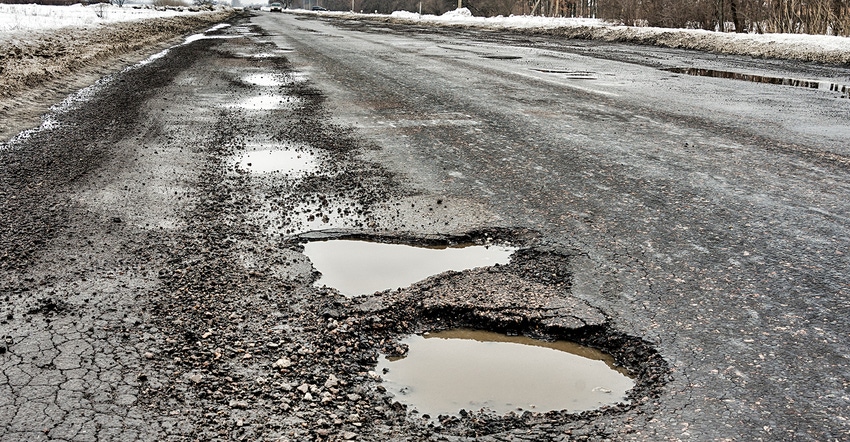March 1, 2019

Minnesota is woefully below average in its care for roads and bridges infrastructure.
Last year, the American Society of Civil Engineers gave the state a D+ grade for its roads and a C for its bridges in its 2018 report card.
What should we have expected, given that adequate funding has not been allocated for years? Our past state lawmakers failed to work in a bold, nonpartisan manner to find solutions for maintenance, repairs and new construction. Instead, the proverbial can has been kicked down an ever-cracking, pothole-filled road.
Given our wicked February weather and the upcoming freeze-thaw cycles, our transportation infrastructure will really show its age.
According to an article last December in the St. Paul Pioneer Press, the Minnesota Department of Transportation estimated it will need $39 billion over the next 20 years to meet its road performance targets. MnDOT at that time projected it will receive $21 billion from current revenue sources to invest in highways over that period, resulting in an $18 billion funding gap — or nearly a $1 billion annual shortfall.
Plus, the article noted that more than 1,000 bridges are in poor condition, and 5% are structurally deficient. MnDOT estimated that over the next decades, more than $5 billion is needed for bridge maintenance but only $3 billion is expected under current law — leaving a $2 billion gap, or more than $100 million a year.
How much for infrastructure upgrades?
So, for a starting point, let’s just say we need $1 billion more per year to start upping those infrastructure grades.
Gov. Tim Walz has proposed raising the gas tax by 20 cents per gallon over two years, and increasing registration fees and vehicle sales taxes to fund a 10-year, $11 billion transportation plan. The tax would be indexed to grow with inflation, starting in 2023, and it would be used on transportation infrastructure and not transit costs.
Along with that proposal, Walz wants to transfer $460 million that is being used for transportation projects back into the General Fund for other priorities. That money was transferred from the General Fund to transportation by Republicans in recent years to spend down the General Fund.
Walz recognizes his administration’s proposal is ambitious.
“This is not a choice between whether we want the gas tax or not,” Walz said at his state budget unveiling. “It is a choice between living in a state with the best transportation system in the country, or one with crumbling roads and bridges that risk our safety and keep away businesses.”
He also shared a conversation he had with a business owner in northwestern Minnesota.
“Hallock has a successful liquor distillery called Far North Spirits that sits on a gravel road,” Walz said. “The owner told me she wants to invest in our infrastructure, because better roads mean better business. She relies on good roads to get her products six hours away to the Twin Cities, where most of her customers live. She also mentioned the need to invest in transit like light rail in Minneapolis and St. Paul, because that’s how her customers get around.”
Walz appreciated the business owner’s view.
“She knows that when the Twin Cities thrive, Hallock thrives. When Mankato thrives, Moorhead thrives,” he said.
The state’s gas tax is currently 28.6 cents per gallon, ranking Minnesota in the middle for gas tax — 24th in the nation and near the national average. Tacking on 20 cents would move the state into the fourth-highest spot.
Since his budget announcement, Walz has heard lots of criticism from business owners, citizens and Republican lawmakers. Yet, the governor insisted he is listening to Minnesotans statewide who want things fixed — and they are willing to pay something.
Poll on taxes to fund roads, bridges
Last October, the Star Tribune and Minnesota Public Radio conducted an 800-person poll that found 56% of respondents supported a 10-cent gas tax increase to build and maintain roads and bridges. The poll did not ask about a 20-cent increase.
State fair surveys by lawmakers have also shown citizens are open to a gas tax increase of some sort. At the 2018 State Fair, the state Senate’s survey found that 40% of respondents agreed with increasing the gas tax for roads and bridges. No increased amount was given.
The state House tweaked its state fair survey in 2018 after asking the gas tax question for several years. Instead, the House survey asked if the state constitution should be amended to require tax revenue from the sale of auto parts and repairs to be dedicated to fund road and bridge improvements. Forty-two percent of respondents favored the amendment, and 39% did not.
In 2016 and 2017, the House surveys specifically asked about raising the gas tax. In both years, 61% of fairgoers supported raising it, 32% voted no and 7% were undecided.
Walz did what he was supposed to do with making the first pitch. That 20 cents was a starting point in negotiations. Rather than hearing “no” and what some lawmakers won’t do, let’s hear opponents’ counteroffers and work toward compromise. We really need civil nonpartisan discussion — and bipartisan consensus — on this pressing issue.
You May Also Like




